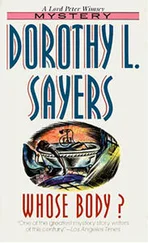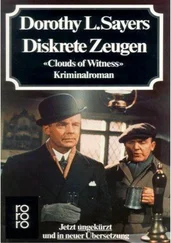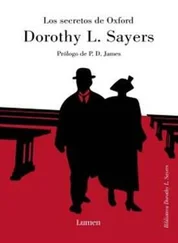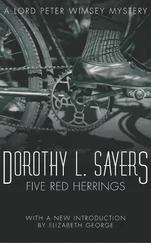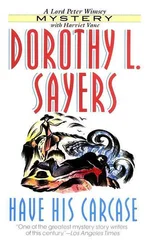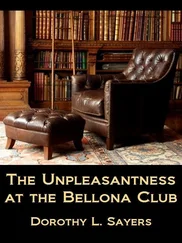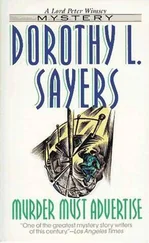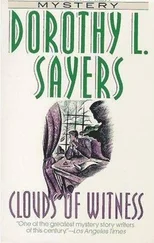Dorothy Sayers - The Nine Tailors
Здесь есть возможность читать онлайн «Dorothy Sayers - The Nine Tailors» весь текст электронной книги совершенно бесплатно (целиком полную версию без сокращений). В некоторых случаях можно слушать аудио, скачать через торрент в формате fb2 и присутствует краткое содержание. Жанр: Классический детектив, на английском языке. Описание произведения, (предисловие) а так же отзывы посетителей доступны на портале библиотеки ЛибКат.
- Название:The Nine Tailors
- Автор:
- Жанр:
- Год:неизвестен
- ISBN:нет данных
- Рейтинг книги:3 / 5. Голосов: 1
-
Избранное:Добавить в избранное
- Отзывы:
-
Ваша оценка:
- 60
- 1
- 2
- 3
- 4
- 5
The Nine Tailors: краткое содержание, описание и аннотация
Предлагаем к чтению аннотацию, описание, краткое содержание или предисловие (зависит от того, что написал сам автор книги «The Nine Tailors»). Если вы не нашли необходимую информацию о книге — напишите в комментариях, мы постараемся отыскать её.
The Nine Tailors — читать онлайн бесплатно полную книгу (весь текст) целиком
Ниже представлен текст книги, разбитый по страницам. Система сохранения места последней прочитанной страницы, позволяет с удобством читать онлайн бесплатно книгу «The Nine Tailors», без необходимости каждый раз заново искать на чём Вы остановились. Поставьте закладку, и сможете в любой момент перейти на страницу, на которой закончили чтение.
Интервал:
Закладка:
“Loud cheers!” said Wimsey. “I’m all for a treasure-hunt. This is confidential, of course?”
“If you please, my lord. You see, if somebody thought it worth while to kill Cranton and smash him up and bury him, and cut off his hands, where he keeps his fingerprints, there’s somebody in this village that knows something. And the less they think we guess, the more free they’ll act and speak. And that’s why, my lord, I was rather glad when the reverend gentleman suggested you coming down here. They’ll talk freer to you than to me — see?”
“Perfectly. I’m a terrific success at pottering round asking sloppy questions. And I can put away quite a lot of beer in a good cause.”
The Superintendent grinned, begged Wimsey to come and see him at any time, clambered into his car and drove off.
* * *
The great difficulty about any detective inquiry is knowing where to start. After some thought, Lord Peter made out the following list of queries:
Identity of the Corpse.
Was it Cranton? — Wait for report on teeth and police report.
Consider the question of the ten-centime piece and the French underclothing. Has Cranton been in France?
When? If not Cranton, is anyone known in the village also known to have been in France at any period since the War?
The destruction of the hands and features after death suggests that the murderer had an interest in making recognition impossible. If the body is Cranton, who knew Cranton (a) by sight? (b) personally?
(Note: Deacon knew him; but Deacon is dead. Did Mary Thoday know him?) Many people must have seen him at the trial.
The Wilbraham Emeralds.
Resulting from the above: Was Mary Thoday (formerly Mary Deacon, née Russell) really after all concerned in the theft?
Who really had the emeralds — Deacon or Cranton?
Where are the emeralds now? Did Cranton (if it was Cranton) come to Fenchurch St. Paul to look for them?
If the answer to 3 is “Yes,” why did Cranton wait till now to make his search? Because some fresh information had lately reached him? Or merely because he was continuously in prison till just lately? (Ask the Superintendent.)
What is the meaning of “Driver’s” interest in Batty Thomas and Tailor Paul? Is anything to be gained from a study of the bells and/or their mottoes?
The Crime.
What did deceased die of? (Wait for experts’ report.)
Who buried (and presumably also killed) him?
Can any clue to the time of the burial be gained by looking up the weather reports? (Snow? rain? footprints?)
Whereabouts did the murder take place? The churchyard? the church? somewhere in the village?
If the sexton’s tools were used, who had access to them? (“Driver,” apparently, but who else?)
Quite a lot of questions, thought his lordship, and some of them unanswerable till outside reports came in. The matter of the bell-mottoes could, of course, be looked into at once. He sought the Rector and asked whether he could, without too much trouble, lay his hand on Woollcott’s History of the Bells of Fenchurch St. Paul, which he had once spoken about. The Rector thought he could, and after he had hunted through all his study shelves and enlisted the aid of Mrs. Venables and Emily, the book was in fact discovered in a small room devoted to the activities of the Clothing Club (“and how it could have got there. I cannot imagine!”). From this work Wimsey distilled the following facts, interesting to archaeologists, but not immediately suggestive of anything in the way of corpses or emeralds:
Batty Thomas (No. 7. Weight 30½ cwt. Note: D). The oldest bell in the ring in her present form, and older still in her original metal. First cast by Thomas Belleyetere of Lynn in 1338. Re-cast, with additional metal by Abbot Thomas of Fenchurch (fl: 1356–1392) in 1380. (This abbot also built the tower and the greater part of the existing nave, though the aisle windows were enlarged in Perpendicular style by Abbot Martin circ. 1423.)
Inscriptions:
Shoulder — NOLI + ESSE + INCREDVLVS + SED + FIDELIS +
Waist — O SANCTE THOMA.
Soundbow — ABBAT. THOMAS. SETT. MEE. HEARE. AND. BAD. MEE. RINGE. BOTH. LOVD. AND. CLEER. 1380.
No record of any other bells at this time, though there was probably at least one other. We know, however, that in the reign of Elizabeth there was a ring of five bells in D of which
John (No. 3. Weight 8 cwt. Note: A) was the original treble. She bears the name of her founder, John Cole, an itinerant founder of the period.
Inscription:
Soundbow — JHON. COLE. MAD. MEE. JHON. PRESBYTER. PAYD. MEE. JHON. EVAGELIST. AID. MEE. MDLVII.
Jericho (No. 4. Weight 8½ cwt. Note: G) was the No. 2 of the old peal, and her maker seems to have thought aggressively well of her.
Inscription:
Shoulder — FROM. IERICHO. TO. IOHN. AGROAT. Yr. IS. NOE. BELLE. CAN. BETTER. MY. NOTE. 1559.
Of the original No. 4, nothing is known. The original No. 3 (F sharp) was a poor bell, flat in pitch and weak in quality. In James I’s reign, this bell was further flattened by the grinding away of its inner surface so as to produce some sort of approximation to F natural, and the great tenor bell was added to make a ring of six in C.
Tailor Paul (No. 8. Weight 41 cwt. Note: C).
A very noble bell of superb truth and tone. She was cast in the Bellfield by the church. (See parish records.)
Inscriptions:
Shoulder — PAVLE + IS + MY + NAME + HONOVR + THAT + SAME +
Soundbow — NINE + TAYLERS + MAKE + A + MANNE + IN + CHRIST + IS + DETH + ATT + END + IN + ADAM + YAT + BEGANNE + 1614
The bells survived the tumults of the Great Rebellion, and in the later part of the century, when the fashion for change-ringing set in, a new treble and second were added to bring the number up to eight.
Gaude (Treble. Weight 7 cwt. Note: C). The gift of the Gaudy family, she bears a “canting” motto.
Inscription:
Soundbow — GAVDE. GAUDY. DNI. IN. LAVDE. MDCLXVI.
The No. 2 of that period was known as Carolus, having been given in honour of the King’s Restoration. This bell, however, was cracked in the 18th century, as a result of the abominable practice of “clappering” the two smallest bells for occasional services, so that the ring was again reduced to six, of which No. 5 (F natural) had always been unsatisfactory. In the first half of the 18th century (that period of ecclesiastical apathy) the worm was allowed to get into the timbers of the bell-cage, as a result of which No. 6 (the Elizabethan No. 4) fell and was broken. Nothing was done until the ’eighties, when an energetic High-Church rector called public attention to the bad state of the bells. Subscriptions were raised, the framework of the bell-cage was repaired and put in order, and three bells were re-cast:
Sabaoth (No. 2. Weight 7¼ cwt. Note: B) was the gift of the Rector.
Inscriptions:
Shoulder — SANCTUS. SANCTUS. SANCTUS. DOMINUS. DEUS. SABAOTH.
Soundbow — RECAST BY JOHN TAYLOR OF LOUGHBOROUGH 1887.
Dimity (No. 6. Weight 14 cwt. Note: E) was given in memory of Sir Richard Thorpe, who died in 1883.
Inscriptions:
Shoulder — RECAST BY JOHN TAYLOR OF LOUGHBOROUGH 1887.
Soundbow — IN. PIAM. MEMORIAM. RICARDI. THORPE. ARMIGERI. NUNC. DIMITTIS. DOMINE. SERVUM. TUUM. IN. PACE.
Jubilee (No. 5. Weight 9½ cwt. Note: F natural). The funds for this bell were raised by public subscription in commemoration of the Queen’s Jubilee, Inscriptions:
Shoulder — JUBILATE. DEO. OMNIS. TERRA.
Waist — RECAST. IN. THE. YEAR. OF. THE. QUEEN’S. JUBILEE. BY. JOHN. TAYLOR. AND. CO. E. HINKINS. AND. B. DONNINGTON. CHURCHWARDENS.
Читать дальшеИнтервал:
Закладка:
Похожие книги на «The Nine Tailors»
Представляем Вашему вниманию похожие книги на «The Nine Tailors» списком для выбора. Мы отобрали схожую по названию и смыслу литературу в надежде предоставить читателям больше вариантов отыскать новые, интересные, ещё непрочитанные произведения.
Обсуждение, отзывы о книге «The Nine Tailors» и просто собственные мнения читателей. Оставьте ваши комментарии, напишите, что Вы думаете о произведении, его смысле или главных героях. Укажите что конкретно понравилось, а что нет, и почему Вы так считаете.

